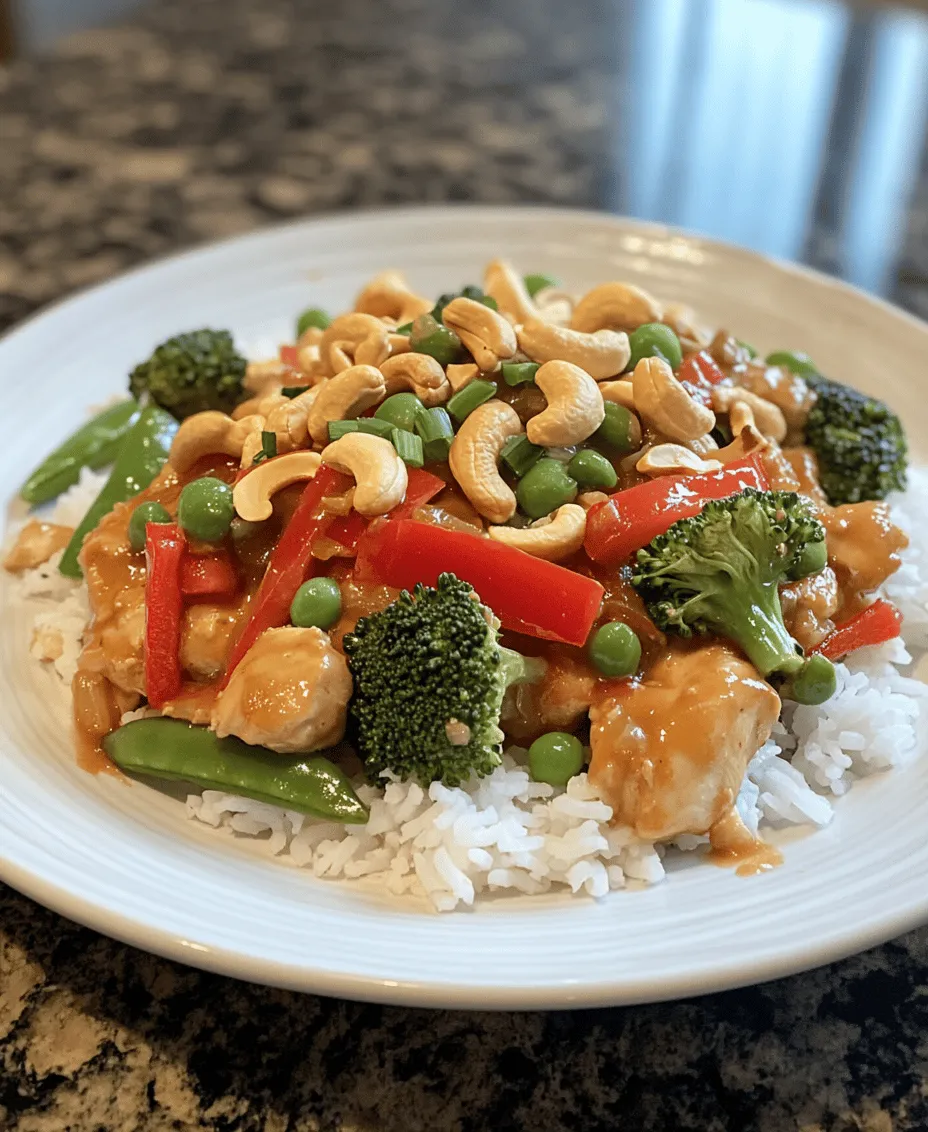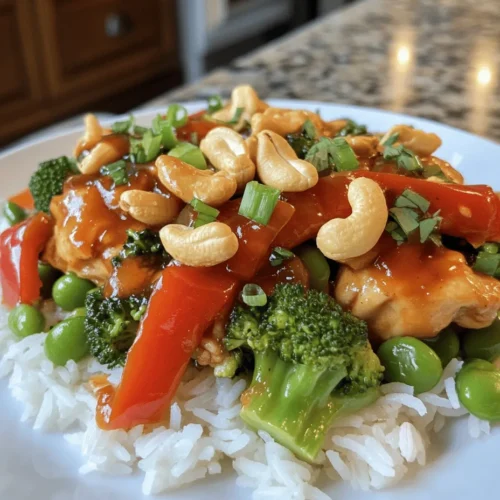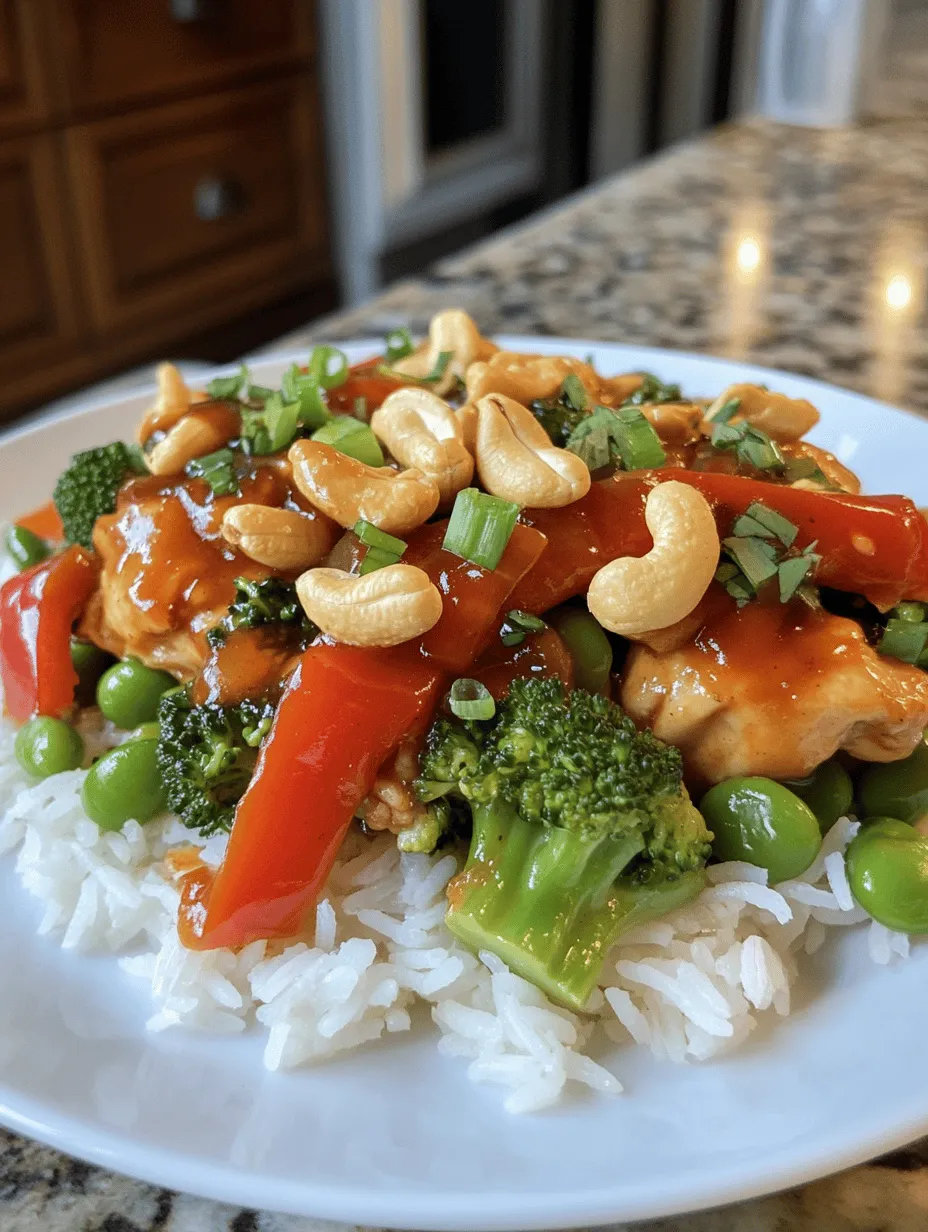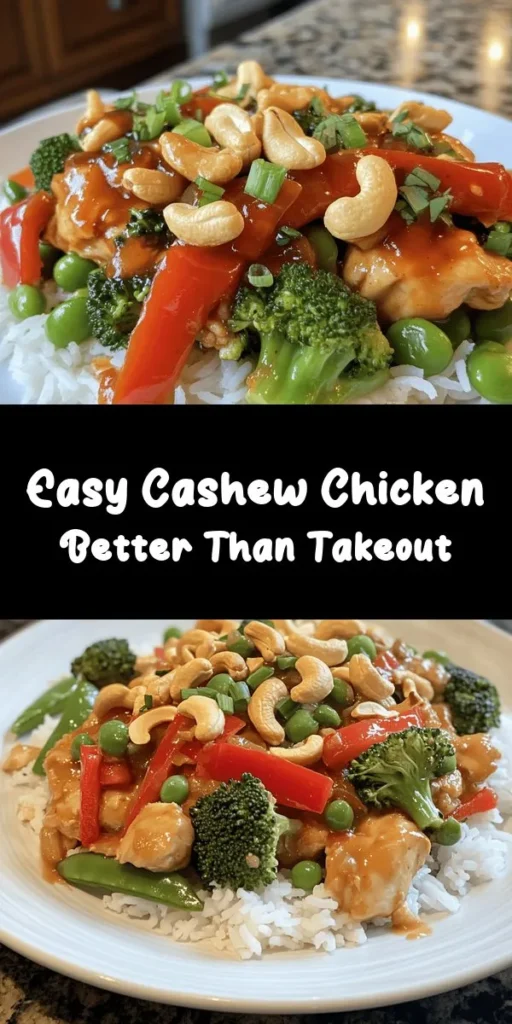Introduction
In recent years, takeout food has become a staple in many households, offering a quick and convenient meal option that caters to our busy lifestyles. However, while ordering in is undoubtedly easy, it often falls short in terms of flavor, freshness, and nutritional value. Enter homemade versions of popular takeout dishes, where you can have the best of both worlds: the convenience of takeout without compromising on taste or health. One dish that perfectly embodies this concept is Better-Than-Takeout Cashew Chicken.
This delightful stir-fry dish combines tender chicken with crunchy cashews and vibrant vegetables, all enveloped in a rich, savory sauce. Making Cashew Chicken at home not only allows you to customize the flavors and ingredients to your liking, but it also offers numerous health benefits. By preparing this dish in your own kitchen, you can control the amount of sodium, sugar, and fat, resulting in a meal that is both satisfying and nourishing. Plus, it’s a great way to impress friends and family with your culinary skills.
Understanding Cashew Chicken
Cashew Chicken has its roots in Asian cuisine, particularly within Chinese culinary traditions. It is believed to have originated in the Guangdong province, where it was brought to the United States in the late 20th century by Chinese immigrants. The dish quickly gained popularity, especially in the Midwest, where it became a beloved staple on Chinese restaurant menus.
Traditionally, takeout Cashew Chicken is stir-fried with a variety of vegetables and tossed in a savory sauce made from soy sauce and other ingredients. However, restaurant versions often come with heavy sauces that can mask the natural flavors of the ingredients and are typically high in sodium and unhealthy fats. By making Cashew Chicken at home, you can create a fresher, more wholesome version that highlights the vibrant tastes of the components while ensuring it meets your dietary preferences.
Nutritional Benefits of the Ingredients
When you prepare Cashew Chicken at home, you have the opportunity to select high-quality ingredients that contribute positively to your health. The primary components of this dish offer a range of nutrients:
– Chicken: Boneless skinless chicken breasts are the ideal choice for this recipe due to their tenderness and lean protein content. Chicken is an excellent source of protein, which is essential for muscle repair and growth, making it a staple in healthy diets.
– Cashews: These nuts are not only delicious but also packed with nutrients. Cashews are a great source of healthy fats, protein, and various vitamins and minerals, including magnesium and zinc. Their creamy texture adds a delightful crunch to the dish.
– Fresh Vegetables: Incorporating vegetables like broccoli, bell peppers, and snap peas enhances the nutritional profile of your Cashew Chicken. Broccoli is rich in vitamins C and K, while bell peppers provide antioxidants and are an excellent source of vitamin A. Snap peas add fiber and a fresh, sweet flavor that balances the dish.
– Aromatics: Garlic and ginger are not just flavor enhancers; they also boast numerous health benefits. Garlic is known for its immune-boosting properties, while ginger can aid digestion and reduce inflammation.
– Sauces: A mix of soy sauce, oyster sauce, and hoisin sauce is what brings this dish together. These sauces add depth and umami flavor, but they can also be high in sodium. Opting for low-sodium versions of these sauces allows you to enjoy the same great taste with less salt.
By carefully selecting these ingredients, you can create a Cashew Chicken that is not only delicious but also a wholesome alternative to the takeout version.
Ingredients Breakdown
To craft the perfect Better-Than-Takeout Cashew Chicken, you will need the following ingredients:
Chicken
– Boneless Skinless Chicken Breasts: Choose fresh, high-quality chicken breasts for the best flavor and texture. They should be trimmed of any excess fat to ensure a lean dish. Cut the chicken into bite-sized pieces to allow for even cooking and easy eating.
Cashews
– Raw or Roasted Cashews: Either option will work, but roasted cashews bring a deeper flavor and added crunch. Ensure they are unsalted so you can control the saltiness of the dish. The nutty flavor of cashews complements the savory sauce beautifully.
Fresh Vegetables
– Broccoli: Cut into small florets for quick cooking. Broccoli adds a satisfying crunch and is a nutritional powerhouse rich in vitamins and minerals.
– Bell Pepper: Use a mix of red, yellow, or green bell peppers for a pop of color and sweetness. Slice them into thin strips to ensure they cook evenly.
– Snap Peas: These add a fresh, crisp texture and a slight sweetness, balancing the dish’s savory elements. Trim the ends and leave them whole for a vibrant presentation.
Aromatics
– Garlic: Fresh garlic cloves minced finely will release their aromatic oils, adding depth of flavor to the sauce.
– Ginger: Fresh ginger, grated or minced, provides a warm, spicy note that elevates the overall taste of the dish.
Sauces
– Soy Sauce: A key ingredient in many Asian dishes, soy sauce brings saltiness and umami flavor. Opt for low-sodium soy sauce to keep the dish healthier.
– Oyster Sauce: This sauce adds a hint of sweetness and complexity. If you prefer a vegetarian option, look for mushroom-based oyster sauce.
– Hoisin Sauce: This thick, sweet sauce adds a unique flavor profile that pairs well with the other sauces. It contributes to the glossy finish of the dish.
Overview of Ingredient Contributions
Each of these ingredients plays a crucial role in creating the perfect Cashew Chicken. The chicken provides a hearty protein base, while the cashews add crunch and healthy fats. Fresh vegetables not only enhance nutrition but also contribute vibrant colors and textures. The aromatics elevate the flavor profile, and the combination of sauces ties everything together, resulting in a dish that is rich, satisfying, and delicious.
Preparation Steps
Now that you’ve gathered your ingredients, it’s time to dive into the preparation process that will lead to your homemade Better-Than-Takeout Cashew Chicken.
Marinating the Chicken
Marinating the chicken is an essential step that infuses flavor and ensures tenderness. Here’s how to do it:
1. Prepare the Marinade: In a medium bowl, combine a couple of tablespoons of soy sauce, a teaspoon of cornstarch, and a splash of sesame oil. The cornstarch will help create a velvety texture when cooked.
2. Add the Chicken: Place the chicken pieces into the bowl and stir to coat them in the marinade. Make sure every piece is well covered.
3. Let it Marinate: Allow the chicken to marinate for at least 30 minutes (or up to 2 hours in the refrigerator). This step is crucial as it enhances the flavor and helps maintain moisture during cooking.
Preparing the Sauce
While the chicken is marinating, you can prepare the sauce that will bring the dish to life:
1. Combine the Sauces: In a separate bowl, mix together ¼ cup of soy sauce, 2 tablespoons of oyster sauce, and 1 tablespoon of hoisin sauce. Adjust the quantities based on your taste preferences; you can add more hoisin for sweetness or more soy sauce for saltiness.
2. Add Aromatics: To the sauce mixture, add minced garlic and grated ginger. This will create a fragrant and flavorful base that will enhance the dish once everything is combined.
3. Set Aside: Once mixed, set the sauce aside. This step ensures that all the flavors meld together before cooking.
With your chicken marinated and sauce prepared, you are now ready to move on to the cooking process, which promises to be quick and rewarding. The next steps will transform these simple ingredients into a mouthwatering dish that rivals your local takeout, all while offering the satisfaction of having made it yourself.

Adjusting the Sauce to Personal Taste Preferences
One of the most appealing aspects of making Better-Than-Takeout Cashew Chicken at home is the ability to customize the sauce to your liking. If you prefer a sweeter profile, consider adding a bit more honey or brown sugar to the mix. On the other hand, if you enjoy a spicier kick, a dash of sriracha or crushed red pepper flakes can elevate the flavor.
For those who are conscious of salt intake, opt for low-sodium soy sauce or tamari, which can help regulate the sodium levels without sacrificing taste. Feel free to play with the balance between sweet, salty, and savory until you find the perfect blend that suits your palate.
Cooking Techniques
Importance of Stir-Frying
Stir-frying is a technique that allows ingredients to cook quickly at high heat, promoting a delightful combination of textures and flavors. This method is crucial for achieving tender chicken and crisp vegetables. To perfect your stir-fry, ensure that all ingredients are prepped and ready to go before you begin cooking. Once the cooking starts, you won’t have time to chop or measure.
Wok vs. Skillet Cooking Methods
While both a wok and a skillet can produce excellent results, the choice between them can affect your dish. A wok is designed for high-heat cooking and allows for quick, even heating, which is ideal for stir-frying. Its sloped sides make it easy to toss and turn ingredients, ensuring they cook uniformly while retaining their color and crunch.
In contrast, a skillet, especially a heavy-bottomed one, can also work well but may require a bit more attention to prevent uneven cooking. If you’re using a skillet, ensure it’s well-heated before adding oil and ingredients for the best results.
Cooking the Dish
Step-by-Step Guide to the Cooking Process
Now that you have your ingredients prepped and your cooking method decided, it’s time to bring your Better-Than-Takeout Cashew Chicken to life. Follow these steps for a successful dish.
Cooking the Chicken: Tips for Achieving the Perfect Golden Brown
1. Heat Your Pan: Begin by heating your wok or skillet over medium-high heat. Add 1-2 tablespoons of oil (like vegetable or peanut oil) once the pan is hot.
2. Add Chicken: Carefully add the marinated chicken to the hot oil in a single layer. Avoid overcrowding the pan, which can lead to steaming rather than frying. Cook the chicken for about 4-5 minutes without stirring until it develops a golden brown crust.
3. Flip and Finish Cooking: Once the first side is browned, flip the chicken pieces and cook for another 3-4 minutes until fully cooked through and no longer pink in the center. Remove the chicken from the pan and set it aside.
Stir-Frying Vegetables: Techniques for Maintaining Crunch and Color
1. Add More Oil: If necessary, add a touch more oil to the pan before introducing your vegetables.
2. Add Aromatics First: Start with aromatics like garlic and ginger, sautéing them for about 30 seconds until fragrant.
3. Stir-Fry Your Veggies: Add your vegetables (like bell peppers, broccoli, and snap peas) in quick succession, starting with the ones that take longer to cook. Stir-fry for about 3-5 minutes, ensuring they remain vibrant and crisp.
4. Maintain High Heat: Keep the heat high throughout the process to prevent the vegetables from becoming soggy.
Combining Ingredients: How to Properly Integrate the Chicken, Vegetables, and Sauce
1. Return Chicken to the Pan: Once the vegetables are just tender, return the cooked chicken to the pan.
2. Pour the Sauce: Drizzle the prepared sauce over the chicken and vegetables. Toss everything together to ensure even coating and distribution of flavors.
3. Simmer Briefly: Allow the mixture to cook together for about 1-2 minutes, creating a harmonious blend of flavors while thickening the sauce slightly.
4. Taste and Adjust: Before serving, taste the dish and adjust the seasoning if necessary, adding more soy sauce or other seasonings as desired.
Recommended Cooking Times for Optimal Results
– Chicken: 8-10 minutes total for perfect golden brown and cooked through.
– Vegetables: 3-5 minutes to maintain their crunch and color during stir-frying.
– Combining Ingredients: 1-2 minutes for blending flavors with the sauce.
Serving Suggestions
To elevate your dining experience with Better-Than-Takeout Cashew Chicken, consider the following accompaniments:
Ideal Accompaniments to Better-Than-Takeout Cashew Chicken
– Rice: Jasmine rice is an excellent choice as its fragrant aroma complements the flavors of the cashew chicken beautifully. Alternatively, consider brown rice for a healthier option or cauliflower rice for a low-carb alternative.
– Noodles: If you prefer a noodle dish, serve the chicken over cooked rice noodles or stir-fried egg noodles, tossing them in the sauce for a full flavor experience.
Suggestions for Garnishing
– Green Onions: Chopped green onions sprinkled on top add a fresh crunch and vibrant color.
– Sesame Seeds: Toasted sesame seeds provide a nutty flavor that pairs perfectly with the dish.
– Fresh Herbs: Consider garnishing with fresh cilantro or basil for an aromatic finish.
Presentation Tips to Enhance the Dining Experience
– Serve in Bowls: Present the cashew chicken in deep bowls for a cozy feel.
– Layered Serving: Create a layered effect by placing a bed of rice or noodles at the bottom, followed by the chicken and vegetables on top.
– Add Color: Include colorful sides, such as steamed broccoli or a side salad, to make the meal visually appealing.
Nutritional Information
For those who are health-conscious, it’s beneficial to know the nutritional breakdown of your meal. Here’s a typical estimate for one serving of Better-Than-Takeout Cashew Chicken (assuming 4 servings total):
– Calories: Approximately 350-400 calories
– Protein: 25-30 grams
– Fat: 15-20 grams (depending on the amount of oil used)
– Carbohydrates: 30-40 grams
Dietary Considerations
– Gluten-Free Options: Substitute soy sauce with tamari or coconut aminos to make this dish gluten-free without losing flavor.
– Balanced Meals: This recipe offers a great balance of protein, healthy fats from cashews, and carbohydrates from rice or noodles, making it a wholesome meal choice.
– Portion Control: Keep in mind that while this dish is delicious, portion control is vital, especially if you’re watching your caloric intake.
Conclusion
Making Better-Than-Takeout Cashew Chicken at home not only satisfies your craving for a flavorful, hearty meal but also allows you to control the ingredients and tailor the flavors to fit your preferences. By following the steps outlined, you can create a dish that rivals any takeout with fresh, wholesome ingredients.
Embrace the joy of cooking and the satisfaction of enjoying a homemade meal that is both healthier and more flavorful than takeout. Whether you’re cooking for family, friends, or just for yourself, this recipe is sure to impress and delight. So gather your ingredients and get started on this culinary adventure today!



